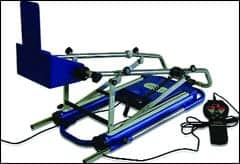 |
| CPM, or continuous passive motion, units accelerate the healing process by slowly and gently flexing and extending joints postsurgery or postinjury. |
While arguments linger at certain insurance companies over whether continuous passive motion is “investigational,” or “medically necessary,” the mission of CPM seems clearly understood among the physical rehabilitation community, where it is widely considered a blue chip technology for promoting joint healing and shortened hospital stays.
“CPM is really superior in terms of its efficacy, and there is a big difference in outcomes for cases when it’s used and not used,” says Laura Keller, MPT, director of rehabilitation for The Stone Clinic in San Francisco.
Clinicians embrace CPM largely because it has delivered technology that spurs the healing process since the early 1970s. When applied to support the recovery of articular cartilage after surgical interventions, CPM stimulates circulation in synovial fluids and accelerates the venous blood flow to improve cartilage nutrition and reduce edema. Within neurological protocols, CPM can decrease pain factors associated with recovery from surgery as well as reduce the probability a patient will develop arthrofibrosis. CPM has even been shown to lower the risk of deep vein thrombosis in trauma patients.
Keller says that, through close observation, The Stone Clinic has found little to impeach the devices as healing agents.
“We do cartilage grafts on both the knee and the ankle, and our opinion is that the real benefits of CPM are realized not when it’s used to achieve a particular functional outcome, but rather when it is used to address the physiological response,” Keller says.
The therapeutic value of CPM becomes subverted, Keller says, when clinicians rely on it to create functional gains “by the numbers.” “When people use CPM as if it’s exercise and as if it’s actually going to freely gain them range of motion, those people are using CPM fallaciously,” she says.
The physiological gains in circulatory health conferred by CPM by no means represent the outer limits of the technology. CPM enjoys an established reputation for efficacy in treating upper and lower extremity conditions rooted in orthopedic, trauma, or neurological origins, and though the technology is mature and fairly versatile, Keller and other rehabilitation professionals agree CPM is not at its best as a solo act.
A STANDOUT, BUT NOT A STAND-ALONE
“If you’re looking at using CPM in lieu of manual therapy and good treatment, it’s just not going to work,” Keller says. “You’re going to be cheating the patient.”
Keller explains that manual therapy used in conjunction with CPM creates significantly better outcomes under protocols associated with cartilage surgeries and joint replacement than when CPM is used alone. And she cautions that CPM devices by themselves do not always provide an accurate gauge of full extension.
“A patient gets excited at the reading on the machine and says, ‘Oh, I got 120!’ ” Keller explains. “Then I tell her, ‘Actually, you got 70.’ “
Jeffrey Schneider, MD, physiatrist for the inpatient musculoskeletal program at Spaulding Rehabilitation Hospital, Boston, like Keller, supports a two-pronged approach to postsurgical joint rehabilitation. He says that in a recent meta-analysis of data collected for patients who received knee replacements, those patients who received standard physical therapy and CPM experienced significantly better improvements in range of motion at 2 weeks after surgery, compared to patients who received physical therapy alone.
“In this way CPM helps patients regain function sooner,” Schneider says. “Likewise, the use of CPM is associated with a decreased length of hospital stay.”
Schneider acknowledges CPM’s brief shelf life, and notes the primary benefits of the therapy occur within the several weeks following surgery, when CPM speeds postoperative healing. Looking at patients 6 months after knee replacement surgery, Schneider says, no difference in range of motion is noted between patients who received CPM and those who did not.
Though the period during which CPM is at its most efficacious may be brief, CPM therapy can account for a significant portion of the inpatient’s daily routine, which in some cases extends for several hours.
“All of our inpatients at Spaulding receive CPM treatment in addition to 3 hours daily of physical and occupational therapy tailored to the patient’s individual needs,” Schneider says. He adds that typically a CPM regimen is prescribed to treat range of motion for patients with knee replacements and lower extremity trauma, including tibia and femur fractures.
PROTOCOLS
Not all postsurgical articular rehab work is a slam dunk for CPM. Procedures such as meniscal allografts, which can be disrupted by CPM, get a pass from the treatment. Keller says that the passive exercises for articular grafts are performed manually, but adds that she consistently observes longer recovery times for patients who are exempted from CPM.
Keller also waves off CPM for postsurgical ACL repairs.
“I believe good manual therapy is going to take you above and beyond what CPM would achieve in ACLs,” Keller says. “With total knee replacements, I believe CPM is good in the hospital and in the home portion of a patient’s protocol.
“The problem with CPM in total knee replacements is that there are certain people—certain doctors—who think CPM provides enough therapy. They think a person is getting all the range of movement they need from CPM and therefore they don’t need to really progress and push physical therapy.”
Keller emphasizes she has never seen a good correlation between mechanized measures of function and a patient’s actual functional ability.
Nonetheless, Keller endorses CPM as a mainstay for microfracture or articular cartilage grafts, and notes The Stone Clinic has adopted protocols that include CPM for knee replacement or uni-compartment knee replacement. CPM also may be used when a patient is believed to shows signs of arthrofibrosis, or it is called into service for its analgesic qualities.
“If a patient has an out-of-parameter pain level with even a post-ACL, we’ll use it for the analgesic effect on a case-by-case basis,” Keller says. “A lot of times if a person’s knee is freezing and the pain from the spasms and the stiffening are quite intense, you’ll find that CPM can actually provide some calming to all those pain receptors.”
Sessions with CPM can be rigorous, and PTs may sometimes rely on their own ingenuity to fit various sized patients into the machines. However, Keller says, patients are generally compliant with CPM and do not question the protocols because they know it helps their recovery and they feel better when they are using it.
Keller adds: “But their consensus at the end of the month is usually: ‘Can I burn this machine now?’ “
A NEW RESOURCE FOR TREATING BURN PATIENTS
Though CPM is perceived as a mature technology throughout physical rehabilitation circles, it is now being looked at with fresh eyes for the promise it may hold among burn patients.
Some use has traditionally been made of CPM in the prevention and treatment of scar tissue contractures. At Spaulding Rehabilitation Hospital, the efficacy of CPM in treating these conditions is being observed through an inpatient setting in a research effort that began last year.
Schneider explains that contractures cause significant functional impairments among burn patients, and are a complication with which doctors and patients must contend throughout the long term. Schneider explains that CPM may expand its role among the conventional treatments for burn injury-caused contractures that involve use of splints, serial casting, and range of motion exercises.
“CPM gives clinicians an additional tool for the prevention and treatment of contractures,” Schneider says. “The burn rehabilitation program at Spaulding is involved in a multidisciplinary research project investigating the efficacy of rehabilitation in this patient population.”
Schneider is the lead investigator of the study.
During a burn patient’s inpatient stay at Spaulding, a great deal of time and effort are spent treating contractures, according to Schneider. And as part of the facility’s treatment protocol, measurements are made to assess the range of motion of all major joints when a burn patient is admitted and when the patient is discharged. Measurements are taken for the shoulder, elbow, ankle, hip, and knee, and then the data are reviewed to determine the effects of treatment.
Assessments are made for contractures, but other outcomes are also tracked, including balance, hand function, quality of life, disposition, post-traumatic stress, and depression.
Patients enrolled in the study are followed up at 6 months and 2 years. According to Schneider, the preliminary data, which was presented in April at the American Burn Association Conference, suggests inpatient rehabilitation therapy interventions have a beneficial impact on contracture treatment.
Frank Long is the associate editor of Rehab Management. For more information, please contact .





